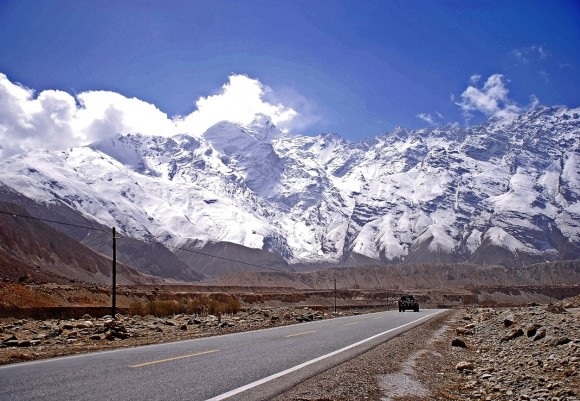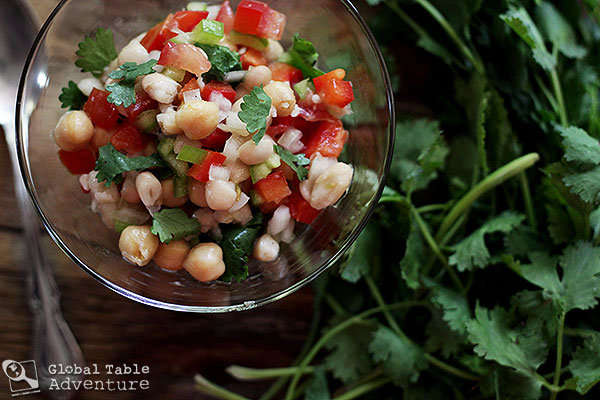No American picnic is really complete without a bean salad. Black beans, green beans or kidney beans, often blended with garbanzos and onions in a light vinaigrette, make for the dreams of many a midsummer picnic. These salads complement roast meats like nothing else and are light, quick and healthy additions to any meal.
Roast meats in the form of kebabs and chops rule menus across western, central and southern Asia. With these kebabs come rice, bread or naan, and usually a light vegetable or bean salad. My favorite of these salads comes from Pakistan and uses garbanzo and northern white beans in a sweet-and-sour vinaigrette of grape-seed oil and white vinegar seasoned with a bit of sugar, black pepper and chilies. Other ingredients include onions, tomatoes, red bell peppers and cilantro. Variations on this theme can be found on stops along the Silk Road with a different combination of beans or lemon juice in place of white vinegar.
Pakistan had an important place on the Silk Road connecting the overland routes with the maritime sea routes. An often-used north-south route running the length of the country connected the Southern Silk Road at Kashgar, China, with Pakistan’s port in Karachi. From Karachi goods could be shipped southeast to Goa, west to ports in Persia or Arabia, up the Red Sea to Egypt, or down the coast of eastern Africa. The road between Kashgar and Karachi is still there today, at least as far as Islamabad, in the form of the Karakoram Highway.

The earliest parts of the Silk Road also ran through northernmost Pakistan and connected the jade mines in western China to the lapis mines in northeastern Afghanistan. Trade in those minerals across the Badakhshan corridor began more than 4,000 years ago. So, from the second millennium B.C., the time of the Indus Valley Civilization, goods from across the region were flowing through Pakistan along with people, cultures and ideas. To this end, the city of Taxila, just west of Rawalpindi and Islamabad, was the site of one of the world’s earliest “universities” where, since the sixth century B.C., learned men traveling the Silk Road came to study.
The Silk Road and Pakistani food
In addition to their ideas, the people traveling the Silk Road also brought their food cultures. Modern Pakistani cuisine is a unique blend of influences from India, western and central Asia, Arabia and the Levant states of the Middle East. The foods from Pakistan’s Sindh and Punjab provinces are most closely related to Indian food, and the curries and other dishes can be quite spicy. Dishes from Pakistan’s two western provinces have commonalities with cuisines of Afghanistan and central Asia. Given the historical importance of the port at Karachi, there are also a few Southeast Asian and Pacific influences, evident in a big way in the use of coconut products, and lime instead of lemon, especially in the south.
The Pakistani Mixed Bean Salad is probably of Arab or Levantine origin given the number of similar salads from those regions. Those salads, however, usually use lemon juice as a souring agent and often contain kidney beans or broad beans, either alone or in combination with other beans. The use of vinegar instead of citrus for souring is probably a Central Asian influence, although it is difficult to be certain.
Chickpeas have been part of the human diet since Ancient Mesopotamian times and believed to have originated in Syria or southeastern Turkey based on the number of wild related species known from these areas. They are rich in protein, carbohydrates and soluble fiber as well as potassium, phosphorus and calcium.
A great deal of the salad’s special flavor comes from grape-seed oil in the dressing. This oil, often extracted after processing for winemaking, is light and sweet and brings the flavor of the grape arbor. A very high flashpoint makes it great for braising and cooking because it’s so difficult to scorch. It also is high in polyunsaturated fats, with 1 tablespoon accounting for 19% of the U.S. recommended daily requirement of vitamin E. It is available in most Persian and Mediterranean markets as well as many large grocery chains. Don’t substitute it, unless there are no options. The added flavor is worth going out of your way to make the purchase.
This salad is moderately spicy when made, but it mellows a lot after marinating. I like to prepare it in the morning, or by noon, and let it rest in the refrigerator for two to three hours. It’s best chilled, but not too cold, so consider taking it out of the fridge and letting it sit at room temperature before serving. I have never met anyone who doesn’t like this salad, especially when it complements steak, chops or other grilled meats.
Pakistani Mixed Bean Salad
Ingredients
1 (15-ounce) can northern white beans or butter beans, rinsed and drained
1 (15-ounce) can of chickpeas, rinsed and drained
1 large onion, peeled and diced
1 medium red pepper, cored and minced
2 medium tomatoes, chopped
2 green chili peppers, minced
⅓ cup white vinegar
⅓ cup of grape-seed oil
1 to 1½ tablespoons sugar
1 to 2 teaspoons salt
1 teaspoon ground black pepper
1 medium bunch fresh coriander leaves, minced
Directions
1. Combine beans, chickpeas, onion, red pepper, tomato and chili peppers into a large bowl. Then whisk together vinegar, oil, sugar, salt and pepper and when well blended, pour over the bean mixture. Mix well.
2. Cover and refrigerate for at least 2 hours. Just before serving, fold in fresh chopped cilantro leaves and stir gently.
(Words, recipe, and photo of the Karakorum Highway by Laura Kelley. Photo of Pakistani Bean Salad by Sasha Martin.)

